Important Aspects We Should Know About Wireless Architecture
NCR Corporation/AT&T in the Netherlands invented Wi-Fi, a popular wireless networking technology that stands for WIreless FIdelity, in 1991. We can exchange information between two or more devices that have been developed for mobile computing, such as laptops, mobile phones, and so on, using this technology. The data is converted into radio signals by the wireless adapter, which is then transmitted via antennas. Wireless signals are important nowadays because they can transmit data such as audio, video, and voice without the use of wires, making them a critical networking requirement in enterprise solutions. They are also the simplest and most cost-effective way to set up Inter or Intra networks. We’ll go over various wireless architectures that can be used in different enterprise networks.
Wireless Architectures
>Autonomous AP Architecture
>Cloud-Based Architecture
>Split-Mac Architecture
–Centralized Wireless Network
>Converged Wireless Network Architecture
Autonomous AP Architecture
Autonomous architecture access points are self-contained and have all the necessary intelligence to serve wireless clients. Each AP offers one or more fully functional WLANs and is equipped with both wired and wireless hardware, allowing wireless client associations to be terminated locally at the AP.
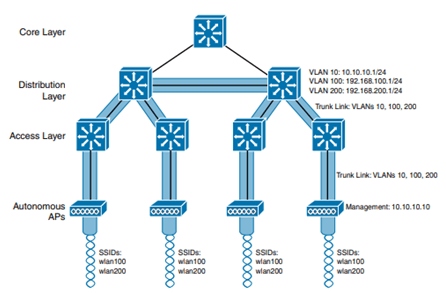
VLANs must be trunked from the distribution layer switch to the access layer switch, where they are extended further over the trunk link to the wireless access point autonomous AP, allowing data to travel between wireless and wired infrastructure in a short and simple path. To be managed remotely, autonomous APs must be configured with a management IP address. These stand-alone APs with fully integrated intelligence and a cost-effective access method are designed for small businesses with limited deployments.
Cloud-Based Architecture
Cloud-Based AP management function is pushed out of the enterprise and pulled into the Internet cloud, where Cisco Meraki is one of the cloud-based solutions that offers centralized management of the wireless network, which is set up similarly to an autonomous AP but management is redirected to the cloud from where we can push out code upgrades and configuration changes to APs in the enterprise.
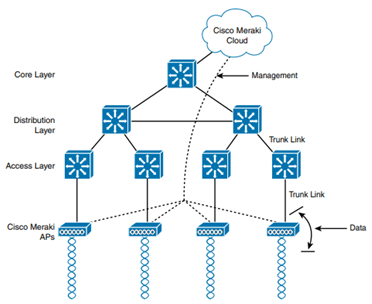
Cloud-based access points are managed, controlled, and monitored centrally from the cloud, and are also known as a hybrid between autonomous and split-mac architecture, in which Meraki access points are autonomous but all management functions are available in the cloud. Administrators who want to be able to oversee deployment from afar will benefit from this management style.
Split-Mac Architecture
Split-Mac means that the management process is split into two streams of data, with access points receiving configuration from a designated Wireless LAN Controller (WLC) which orchestrates the entire process and has the ability to see and coordinate all access points centrally, resulting in lower overhead costs for large-scale deployments. In split-Mac architecture, the entire data process and real-time functions are going to be handled by wireless access points themselves and the management function goes to the wireless controller for multiple APs, which must be configured to cover as many APs as possible. Split-Mac architecture divides the implementation of Mac functions between the AP and the WLC because the core layer WLCs need to have a centralized view of the network, and the WLCs take away some of the AP’s intelligence, which is why they’re called Lightweight APs. When a lightweight AP boots, it uses the discovery mechanism to search for and connect to a WLAN controller because it can’t function without one.
Centralized Wireless Network
Access points are configured and managed using Control Messages. Messages are authenticated and encrypted at the controller to ensure that they are not intercepted and can be securely shared between WLC and LAP. UDP 5246 is used for this.
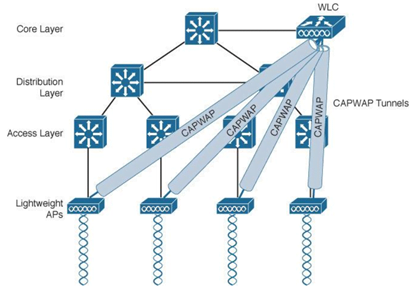
Traffic to and from wireless users passes through CAPWAP tunnels to reach the network’s core, where a centralized WLC provides a convenient location for enforcing security policies that affect all users. In this design, lightweight access points only perform real-time 802.11 operations; all management functions are typically handled by the wireless LAN controller.
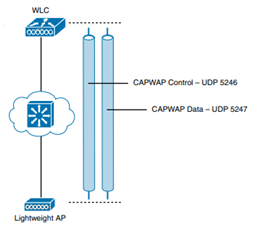
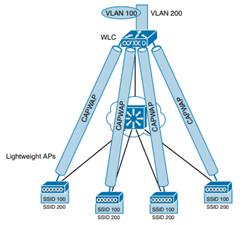
Converged Wireless Network Architecture
When we want a WLC to be closer to the APs and handle more distribution functions, we move the wireless LAN controller down to the Access Layer. The WLC function is moved closer to the LAPs and wireless users in this architecture where the WLC function is distributed rather than centralized. The wireless controllers can be found in the access layer, which has all types of user access merged into one layer called a converged wireless network, and these converged controllers are known as Wireless Control Modules (WCM).
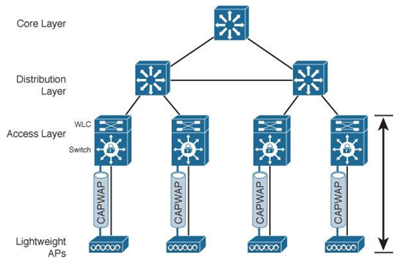
Another benefit of the converged network architecture is the wireless capability, which allows you to connect a wireless LAN controller and an access point to the same access layer switch. Lightweight access points connect to the wireless controller via an access/distribution switch, resulting in a shorter CAPWAP distance, faster Wi-Fi, and fewer connectivity delays.
The most appropriate network layout is critical to any system’s efficient operation. This is especially important in wireless networks because latency, power, speed, and redundancy are all closely related.
Zindagi Technologies, through the use of adaptive technologies and a tried-and-true method of hands-on experiences, is the industry’s one of the leading providers of IT consultancy. With a focus on advanced networking technologies, next-generation security, and infrastructure cloud, the company’s portfolio caters to all levels of the enterprise and corporate deployments. If you are planning for any such kind of deployment which includes planning, designing, and implementation, you can always reach out to us or you can also give us a call at +919773973971.
Author
Rajat Goyal
Project Lead
